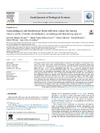Please use this identifier to cite or link to this item:
https://accedacris.ulpgc.es/jspui/handle/10553/122664
| Title: | Haematological and biochemical blood reference values for Canary Island camels (Camelus dromedarius), an endangered dromedary species | Authors: | Martín Barrasa, José Luis Tejedor Junco, María Teresa Cabrera, Soraya Morales Doreste, Manuel Francisco Melián Henríquez, Adrián Corbera Sánchez, Juan Alberto |
UNESCO Clasification: | 310904 Medicina interna | Issue Date: | 2023 | Journal: | Saudi Journal of Biological Sciences | Abstract: | The purpose of this research was to develop reference values for haematological and biochemical vari- ables in the Canary camel breed (Camelus dromedarius). 114 clinically healthy dromedary camels were assessed. Age, sex, and pregnancy status was also recorded. The reference range for red blood cells (RBCs) was 8.45 – 13.65 X10 6/lL, haemoglobin (HGB) was 10.61 – 15.29 g/dL, packed cell volume (PCV) was 19.93 – 32.51 %, and white blood cells (WBCs) 7.35 – 18.36 X10 3/lL. A correlation was estab- lished between the haemoglobin concentration (HGB) (g/dl) and packed cell volume (PCV) obtaining a linear regression (HGB = 0.31 PCV + 4.67). Young animals had higher RBC and WBC values than adult ani- mals. Additionally, blood urea nitrogen (BUN), phosphorus, calcium, albumin/globulin (A/G) ratio, alka- line phosphatase, cholesterol, and lipase were higher in young animals compared with adults. Female dromedary camels showed higher values for the three main variables: RBC, HGB and PCV, but no differ- ences between sexes were detected in the biochemical variables results. The WBC count was higher in non-pregnant females than in pregnant animals. These results provide references values for the Canary camel breed and may contribute to the understanding of differences in 18 haematological and biochem- ical parameters in dromedary camels with a potential impact in health and welfare for this species. Ó 2023 The Author(s). Published by Elsevier B.V. on behalf of King Saud University. | URI: | https://accedacris.ulpgc.es/handle/10553/122664 | ISSN: | 1319-562X | DOI: | 10.1016/j.sjbs.2023.103677 | Source: | Saudi Journal of Biological Sciences [ISSN 1319-562X], v.30, 2023 |
| Appears in Collections: | Artículos |
WEB OF SCIENCETM
Citations
6
checked on Jun 8, 2025
Page view(s)
81
checked on Apr 27, 2024
Download(s)
219
checked on Apr 27, 2024
Google ScholarTM
Check
Altmetric
Share
Export metadata
Items in accedaCRIS are protected by copyright, with all rights reserved, unless otherwise indicated.
